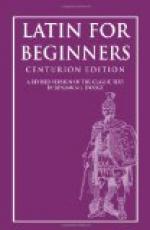arbor, arboris\, f., _tree_ (arbor)
collis, collis (-ium)\, m., hill
de:ns, dentis (-ium)\, m., _tooth_
(dentist)
fo:ns, fontis (-ium), m.. _fountain,
spring; source_
iter, itineris\, n., march, journey,
route (itinerary)
me:nsis, me:nsis (-ium)\, m., _month_
moenia, -ium\, n., plur., walls,
fortifications. Cf. mu:rus\
mo:ns, montis (-ium)\, m., mountain;
summus mo:ns\, _top of
the mountain_
numquam\, adv., never
po:ns, pontis\, m., _bridge_ (pontoon)
sanguis, sanguinis\, m., blood (sanguinary)
summus, -a, -um\, _highest, greatest_
(summit)
tra:ns\, prep, with acc., across
(transatlantic)
vi:s (vi:s)\, gen. plur. virium\,
f. strength, force, violence
(vim)
246. PARADIGMS
[Transcriber’s Note: The original text gives vi:- and vi:r- as the “Bases” of vi:s\, and omits the “Stems” for both words. The forms have been regularized to agree with the inflectional table in the Appendix.]
vi:s, f., _force_ iter, n., _march_ STEMS vi:- and vi:ri- iter- and itiner- BASES v- and vi:r- iter- and itiner-
SINGULAR Nom. vi:s iter Gen. vi:s (rare) itineris Dat. vi: (rare) itineri: Acc. vim iter Abl. vi: itinere
PLURAL Nom. vi:re:s itinera Gen. vi:rium itinerum Dat. vi:ribus itineribus Acc. vi:ri:s, or -e:s itinera Abl. vi:ribus itineribus
_247._ There are no rules for gender in the third declension that do not present numerous exceptions.[1] The following rules, however, are of great service, and should be thoroughly mastered:
1. Masculine\ are nouns in -or, -o:s, -er, -es (gen. -itis).
a. arbor\, _tree_, is feminine; and iter\, march, is neuter.
2. Feminine\ are nouns in -o:, -is,
-x, and in -s preceded by
a consonant or by any long vowel but o:\.
a. Masculine are collis\
(_hill_), lapis\, me:nsis\ (_month_),
o:rdo:\, pe:s\, and
nouns in -nis and -guis—as ignis\,
sanguis\ (_blood_)—and
the four monosyllables
de:ns\, _a
tooth_; mo:ns\, a mountain
po:ns\, _a
bridge_; fo:ns\, a fountain
3. Neuters\ are nouns in -e, -al, -ar,
-n, -ur, -us, and
caput\.
[Footnote 1: Review Sec.
60. Words denoting males are, of course,
masculine, and those denoting
females, feminine.]
248. Give the gender of the following nouns and the rule by which it is determined:
animal calamitas flumen lapis navis avis caput ignis legio opus caede:s eques i:nsigne mare salu:s calcar fi:nis labor mi:les urbs
249. EXERCISES




